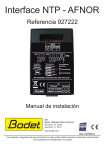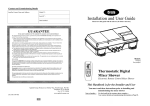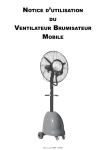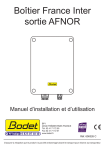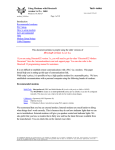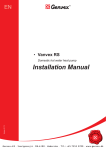Download Bodet Profil 960 Operating instructions
Transcript
Clock Profil 960 For indoor or outdoor models INSTALLATION AND OPERATING INSTRUCTIONS B.P. 1 49340 TRÉMENTINES FRANCE Tél. : 02 41 71 72 00 Fax : 02 41 71 72 01 www.bodet.com Réf. : 605775 K When receiving goods please chek nothing is broken otherwise make a claim near shipping company. Table of contents I - INITIAL VERIFICATION . . . . . . . . . . . . . . . . . . . . . . 3 1.1 Unpacking the clock . . . . . . . . . . . . . . . . . . . . . . . . . . . . . . . 3 1.2 Cleaning . . . . . . . . . . . . . . . . . . . . . . . . . . . . . . . . . . . . . 4 II - INSTALLATION . . . . . . . . . . . . . . . . . . . . . . . . . . 4 2.1 Single face indoor clock . . . . . . 2.2 Single Face outdoor clock . . . . . 2.3 Double Face clock . . . . . . . . . 2.3.1. Double Face integrated clock 2.3.2 Clock on keyboard . . . . . . 2.4 Setting the antenna . . . . . . . . . . . . . . . . . . . . . . . . . . . . . . . . . . . . . . . . . . . . . . . . . . . . . . . . . . . . . . . . . . . . . . . . . . . . . . . . . . . . . . . . . . . . . . . . . . . . . . . . . . . . . . . . . . . . . . . . . . . . . . . . . . . . . . . . . . . . . . . . . . . 4 5 5 6 7 7 III - POWER SUPPLY . . . . . . . . . . . . . . . . . . . . . . . . . 8 3.1. AFNOR HM clock 230V : . . . . . . . . . . . . . . . . . . . . . 3.2. DHF HM 230V clock : . . . . . . . . . . . . . . . . . . . . . . . 3.3. AFNOR HM clock low voltage 6/24V . . . . . . . . . . . . . . . 3.4. France Inter servo second clock : . . . . . . . . . . . . . . . . . 3.5. Independent Quartz clock on mains : . . . . . . . . . . . . . . . 3.6. Minute, ½ minute, with synchronous second hand clock receiver . 3.7. Lighting connection . . . . . . . . . . . . . . . . . . . . . . . . . . . . . . . . . . . . . . . . . . . . . . . . . . . . . . . . . . . . . . . . . . . . . . . . . 8 8 9 9 10 10 11 IV - OPERATING AND TIME SETTING. . . . . . . . . . . . . . . . 12 4.1. Impulses slave clock . . . . . . . . . . . . . . . . . . 4.1.1. ½ minute and minute 24V // receiver, . . . . . . 4.1.2. ½ minute and minute serial receiver, . . . . . . 4.2. AFNOR/IRIG-B time signal reception . . . . . . . . . 4.2.1. Time signal reception HM 230V (Hour - Minute) 4.2.2. Time signal reception TBT 6/24V . . . . . . . . 4.3. France Inter radio receiver clock . . . . . . . . . . . 4.4. DHF clock . . . . . . . . . . . . . . . . . . . . . . . 4.5. Independent Quartz on mains with remote keyboard . . . . . . . . . . . . . . . . . . . . . . . . . . . . . . . . . . . . . . . . . . . . . . . . . . . . . . . . . . . . . . . . . . . . . . . . . . . . . . . . . . . . . . . . . . . . . . . . . . . . . . . . . . . . . . . . . . . . . . 12 12 13 14 14 14 15 15 16 V - TECHNICAL FEATURES . . . . . . . . . . . . . . . . . . . . . 17 VI - WHAT TO DO IF...? 2 ...CHECK.. . . . . . . . . . . . . . . . . 20 ENGLISH I - INITIAL VERIFICATION Thank you for choosing a BODET clock. This product has been carefully designed for your satisfaction based on ISO9001 quality requirements. We advise you to read this manual thoroughly before attempting to manipulate the clock. Keep this booklet during all the life of your clock, so that you can refer to it each time it is necessary. Bodet accepts no responsibility for accidents resulting from any use not conforming with the above provisions. Any modification to the product will invalidate the warrantee. 1.1 Unpacking the clock Unpack with caution and check the contents of the packaging. It must contain : - the Profil clock, - for radio synchronised models : the antenna, - for outdoor models : a key to open the casing, - an antistatic cleaning kit, - this booklet. Versions : a label inside the clock specifies what model the clock is : AFNOR HM 230v = the clock is a receiver driven by a master clock that sends AFNOR NFS-87500A time coded messages ; it is powered by 240 VAC. AFNOR HM TBT = the clock is a receiver driven by a master clock that sends AFNOR NFS-87500A time coded messages ; it is supplied in low voltage 6 / 24 V AC or DC. AF/FI HM = the clock is a receiver driven by : a master clock that sends AFNOR NFS-87500A coded time messages or a radio France Inter receiver antenna, and powered by 240 VAC. 1/2 MN 24V = the clock is a receiver driven by a master clock that sends 1/2 minute impulses on a parallel line. MN 24V = the clock is a receiver driven by a master clock that sends minute impulses on a parallel line. 24V + SEC = the clock is a receiver driven by a master clock that sends minute impulses on a parallel ligne ; it is powered by 240 VAC, with a servo second hand. 1/2MN SER = the clock is a receiver driven by a master clock that sends ½ minute impulses on a serial line. 1/2MN SEC = the clock is a receiver driven by a master clock that sends ½ minute 3 impulses on a serial ligne ; it is powered by 240 VAC, with a servo second hand. REC MN 1V5 = the clock is a receiver driven by a control unit “Remote keyboard” or radio synchronised control unit “BT radio” that sends minute impulses. RAD DHF = the clock is radio-synchronised by a DHF transmitter and battery supplied. DHF HM 230V = the clock is radio-synchronised by a DHF transmitter; it is supplied in 240VAC. 1.2 Cleaning Use an antistatic product of similar type to the one shipped in the original packaging. Never use alcohol, acetone or any other solvent liable to damage the casing and glass on your clock. II - INSTALLATION Select the place where the clock will be installed while making sure that radio reception is correct for radio synchronisation models. The radio receiver clock should be installed in a place that is free from electrical interference (cathode tube, transformers, etc.). Avoid fixing the clock directly to a metal plate or reinforced concrete wall. The clock orientation (dial perpendicular to the emitter direction) towards the emitter enhances the reception. The best reception conditions are outside buildings or near by a window. 2.1 Single face indoor clock 3 572 - Drill the support to the required dimensions. - Place the 2 screws Ø6 (1) with their washers. - If necessary, carry out the various connections (external supply : see page 8 and connection to a time distribution network : see page 12). - Hang the clock and screw it with a size 10 flat key. 3 2 1 1 8 4 2.2 Single Face outdoor clock 1 11 2 9 4 8 4 3 7 5 6 5 3 4 2 6 2 1 7 1 9 3 8 12 10 N - Carry out the various connections (external supply : see page 8 and connection to time distribution network : see page 12). 12 L - Hang the clock and fix it with M8 screws (4), without locking it, after you have put the wires (between Ø7 and Ø10) through the waterproof pressure joints (5). 11 10 Ø 440 mm - Open the clock by giving the 2 screws (3) a quarter turn with the key (1), and then pull the whole dial towards you (hinge arm opening). The hinge arm opening system ensures a fast and secure maintenance of the lighting without having to put the front part of the clock on the ground. 1 - Lock the clock. - Power it. - Reset the time if necessary. - Close the clock. 5 2.3 Double Face clock 2 models of double face clocks are available : - One model with an integrated bracket that includes two back to back dials. - One model with a hinged arm system that holds two single face clocks. 5 2.3.1. Double Face integrated clock 150 70 Drill the support (wall, pillar, ...) to the required dimensions and fix the bracket. Ø9 - Unscrew by 10 mm the 2 bolts (B) on each face. B - Remove each face by rotating them anticlockwise (for receiver clocks, Do Not forget to disconnect the 2 movements). 6 7 - Fix the double sided bracket after you have put the wires either through the plate support (6), or through the aperture on the side of the bracket (7). B - Carry out the various connections (external supply : page 8 and time distribution network : page 12). - Power the clock and reset the time if necessary. - Place each face on the bracket and rotate them clockwise to place the clock in its final position. - Screw the bolts (B) to lock the clocks in rotation. 6 B L Ecl N 230V 0.5 2.3.2 Clock on keyboard 150 70 - Drill the support (wall, pillar, ...) to the required dimensions and then fix the bracket. - If necessary, carry out the various connections (external supply : page 8 and connection to time distribution network : page 12). - Put the wires either through the hinged arm system (6), or through the hole on the side of the bracket (7). - Fix the clock (or clocks) to this keyboard with the 2 threaded shafts (C). 7 Ø9 6 C 2.4 Setting the antenna For radio synchronised clocks : The best reception conditions are outside buildings or near windows. Positioning the antenna (perpendicular to the direction of the transmitter) improves reception. The antenna must not be placed on a metal support. As for any radio system, a building with metal structures can cause interference in the reception of the signal. Computers, television sets and electrical appliances can also cause interference that disrupt the reception of the radio message. - Unlock the antenna from its support. - Fix the support with the screw supplied and lock the antenna again. Beware : in a double face system. So as not to cause interference between the 2 antennas, the latter must be fixed at least one metre away from each other. 7 III - POWER SUPPLY Installation and maintenance of this equipment must be carried out by qualified personnel only. Electrical installation must comply with current standard CEI 364. (NF C15-100 in France for example). The mains supply for the clocks must include a neutral phase circuit breaker 10A C curb, rapidly accessible. This circuit breaker must be switched off during maintenance operations. Note : the power supply wires must be linked near their fixing point. 3.1. AFNOR HM clock 230V : N ! N 230V L F STOP Permanent power supply 230V - Connect mains supply 230 Volt 50 Hz to the power terminal: max.1.5 mm2 wire and stripped over 5 mm. - Lock the wires with collars. Permanent power supply 230V N 230V L 2 3.2. DHF HM 230V clock : Ecl 0.5A 1 2 N L This card is protected by 1 fuse (F) 0,2AT 250V. 8 Ecl 0.5A START ! - Lock the wires with collars. L - Connect mains supply 230 Volt 50 Hz to the supply card terminal : max.1,5 mm2 wire and bare 6 on 5 mm. 3.3. AFNOR HM clock low voltage 6/24V Connect the low voltage (TBT) power supply (6 to 24V AC or DC) to the connectors 1 and 2: maximum 1,5 mm2 wire section (5mm bare). It is compulsory, for a correct running, to respect the following parameters. These parameters are calculated considering 8/10 mm wire section with 1A (Microquartz Delta). Distance 100 m 200 m 300 m 400 m 500 m 600 m 1 km 2 3 4 1 2 3 4 1 10 20 30 40 50 Distance in m 24VDC 15VDC 8300 3200 830 320 415 160 275 105 208 75 165 45 1 Number of clocks Number of clocks 24VDC 15VDC 71 32 41 16 27 10 20 6 16 6 13 5 8 3 3.4. France Inter servo second clock : - Connect mains supply 230 Volt 50 Hz to the supply card terminal : max. 1,5 mm2 and bare on 5 mm. The earth wire must be longer than those of live and neutral. 7 This card is protected by 2 fuses (F) 2A 250V. - Connect the terminal (7) of the battery, on this main card. L 0 230 F 1 2 3 - Lock the wires with collars. N Permanent power supply 230V 9 3.5. Independent Quartz clock on mains : Single Face. – Connect mains supply (230VAC) to the terminal (20) of the power supply unit (ref.933006). 20 22 – Connect the impulses line between the terminal (22) of the power supply unit and the terminal (2) of the clock. The time base is protected by a 0,2AT / 250V fuse (21). 21 23 Double Face. – Connect mains supply (230VAC) to the terminal (20) of the power supply unit. – Connect the impulses ligne between the terminal (22) of the power supply unit and the terminal (2) of the clock. N L N 1 2 1 2 2 Impulses L – Check that the dip switch (23), on the card of the time setting box, is in “DF” position. 3.6. Minute, ½ minute, with synchronous second hand clock receiver 2 L N Connect permanent power supply 230V +earth on the terminal (4). 24V // receiver + second hand Impulses Permanent power supply 230V +earth 1 – The second hand is driven by an independent motor. This motor must be permanently supply. N 4 ½ minute serial receiver + second hand L N L N 1 2 - Nota : the power supply wires should be assembled together near their connecting terminal. Lighting 230V + earth L The earth wire must be longer than the other ones. 10 Impulses Permanent power supply 230V + earth Lighting 230V + earth 3.7. Lighting connection A 10 A fuse or circuit breaker for the lighting power supply should be installed and switched off prior to any maintenance in the clock. N L Lighting 230V + earth N 1 1 2 2 2 L – Connect lighting supply 230V + earth (0,55A) on the terminal (2), the earth wire must be longer than the other ones. – Nota : the power supply wires should be assembled together near their connecting terminal. 11 IV - OPERATING AND TIME SETTING NOTA : to respect the security rules, the time distribution network must be be SELV-type. - The impulses wires should be assembled together near their connecting terminal. 4.1. Impulses slave clock A time distribution network emits only impulses, so that it is necessary to set the clock at the time of this network. To add a clock on a network, it is necessary to stop this network and to set on time the clock. To set on time the clock, turn the control knob (7 or 8). 4.1.1. ½ minute and minute 24V // receiver, 7 2 - Connect the time distribution network to terminals 1 and 2 on the terminal strip (3). 1 Impulses Leave works 2 minutes. - If the clock, or one of the clocks in case of a double side mounting, is one minute (or ½ minute according to the movement type) late : stop the emitter, reverse the connection on terminal (3) and put the clock forward 2 minutes (or 1 minute), then restart the emitter. In fact, the same impulse is either positive or negative according to the way to connect and the initial position of the movement, it will take or not the first impulse. 12 2 1 N 3 L Nota : in some clocks (double face, waterproof, ...), an intermediate terminal allows to connect impulses ligne easily. 3 8 Synchronous second hand movement 4.1.2. ½ minute and minute serial receiver, - Connect the time distribution network to terminals 1 and 2 on the terminal strip (3). 2 1 3 2 1 3 Impulses 1 To insure the continuation of the serial distribution network, (to avoid to cut the serial line when a slave clock is disconnect) connect the 100 Ohms 1/2 Watt resistor delivered (for 65mA). Leave works 2 minutes. 3 2 - The terminal 3 of the terminal strip (3) is available. You can use it to connect a double side clock following the diagram opposite. 8 L N - If the clock, or one of the clocks in case of a double side mounting, is ½ minute (or one minute according to the movement type) late : stop the emitter, reverse the connection on terminal (3) and put the clock forward 1 minute (or 2 minutes), then restart the emitter. In fact, the same impulse is either positive or negative according to the way to connect and the initial position of the movement, it will take or not the first impulse. 13 4.2. AFNOR/IRIG-B time signal reception Operating principle of AFNOR HM receiver clock : During 1 hour without reception of the time signal the clock operates with its own time basis. If the signal recovery is achieved within this hour, the clock will be resynchronised automatically. After 1 hour the clock is reset and hands are set on position 12.00. - When switching on power supply, hands are set at 12.00 until the correct reception of the time signal is achieved. After 3 successive coherent AFNOR time signals are received, the clock starts and automatically get on time with fast impulses. 4.2.1. Time signal reception HM 230V (Hour - Minute) - Connect the time signal network to the upper terminals of the AFNOR receiver card. Caution: to avoid interferences due to high voltage lighting, the wire between the cable gland and the terminal must be as short as possible. - Check that the dip switch (6), on the AFNOR impulse card, is pushed toward left of the PCB (start position). 6 START STOP N L AFNOR input Operating with battery : - Without power supply 230V the clock operates with its battery during 1 hour. - After 1 hour without time signal reception or if the battery voltage drops down, hands are set position 12.00 until power supply recovery. 4.2.2. Time signal reception TBT 6/24V - Connect the afnor line on connectors 3 and 4. 2 3 4 1 2 3 4 14 1 - When receiving the power, the hands are driven to 12h00 until the clock receives a radio signal. After controlling the data (3 coherent messages) the clock is automatically driven to the current time by accelerated impulses. 4.3. France Inter radio receiver clock Antenna connection : Connect the 2 wires of the antenna on the FI and GND terminal. Caution: to avoid interferences due to high voltage lighting, the wire between the cable gland and the terminal must be as short as possible. 16 17 15 Check that the dip switch (15) is in France-Inter receiver position, push toward the down of the PCB. When switching on power supply, hands are set at 12.00 until the correct reception of the time signal is achieved or a manual setting on time is done. After 3 successive coherent France-Inter time signals are received, the clock starts and automatically get on time with fast impulses. Manual time setting : – At the first press on button “time setting” (17) , the internal clock starts. – Every press on button “time setting” (17) advances the clock by one minute. – After this manual time setting, the clock operates in stand alone mode until reception of the signal, or reset function by pressing button (16) or a power supply failure. Operating principle of France Inter receiver : – Once the clock is synchronised, it will operates with its own time basis even if there is no more reception until there is no power failure. Operating with battery : – Without power supply 230V the clock operates with its battery during 1 hour. – After 1 hour without time signal reception or if the battery voltage drops down, hands are set position 12.00 until power supply recovery. – The synchronous second hand witch is powered by the main 12V 50Hz, will stop immediately. 4.4. DHF clock Ensure that the transmitter is set in “Init” mode. Switch the clock power on (for models with batteries, insert the batteries matching the polarities), the hands will move forward by 2 minutes. The clock will try to pick up the radio signal. If the reception is good, the clock is synchronised automatically. If the reception is bad, increase the transmission power or install a DHF repeater. 15 4.5. Independent Quartz on mains with remote keyboard See the booklet of the remote keyboard, reference : 605198. Attention : in case of a double face clock, check that the Dip switch (6) of the remote keyboard is in “DF” position. 16 V - TECHNICAL FEATURES Readability : Dimensions : 60m. Profil 960 Indoor Profil 960 Outdoor 166 Ø 660 11 12 1 11 2 10 9 3 7 5 6 Profil 960 Double face Indoor 12 4 3 Ø660 11 150 9 3 6 12 1 10 2 8 4 9 4 8 5 70 2 7 6 1 10 150 8 Double Face integrated Outdoor: Ø660 11 2 7 70 1 9 4 8 12 10 660 82 3 7 5 150 6 5 150 192 234 Mounting on bracket - Outdoor clocks 150 70 150 660 11 12 1 10 2 8 4 9 3 7 189 6 5 342 17 France Inter radio receiver clock with synchronous second hand : Permanent power supply : 230V; 70mA. Accuracy : absolute with automatic summer/winter changeover. The electronic of the clock is protected by 2 fuses 2A/250V. Receiver radio DHF : Power supply : 2x 1,5V LR14 batteries. Autonomy : > 3 years. Accuracy of the master clock. DHF 230VAC clock : Power supply : 230VAC 0,2A. Accuracy of the master clock. Independent Quartz on mains with remote keyboard clock : Supply : 230VAC 0,2A. Accuracy : 1 minute/year. The electronic of the clock is protected by a fuse 0,2AT/250V. Receiver impulses Minute 24V // HM : Reversed polarised minutes impulses 9,6 mA. Accuracy of the master clock. Receiver impulses Minute 24V // with synchronous second hand : Reversed polarised minutes impulses 9,6 mA. Permanent power supply : 230V; 15mA. Accuracy of the master clock. Receiver impulses ½ minute serial HM : Reversed polarised ½ minutes impulses 0,9V/65 mA. Accuracy of the master clock. Receiver impulses ½ minute serial with synchronous second hand : Reversed polarised ½ minutes impulses 0,9V/65 mA. Permanent power supply : 230V; 15mA. Accuracy of the master clock. AFNOR/IRIG-B time signal reception HM 230V : Permanent power supply : 230V; 15mA. Accuracy of the master clock. The electronic of the clock is protected by 2 fuses 2A/250V. AFNOR/IRIG-B time signal reception HM TBT 6/24V : Permanent power supply : 6/24V AC or DC ; Consumption : from 41mA at 6V to 14mA at 24V. Accuracy of the master clock. In case of power cut the time is memorised. 18 Supply Operating temperatures Protection index Weight Profil 960 I HM minute // and ½ minute serial receiver -10°C to +50°C IP401 6,5 kg Profil 960E HM minute // and ½ minute serial receiver -25°C to +70°C IP537 15,2 kg Profil 960E HM DFE minute // and ½ minute serial receiver -25°C to +70°C IP437 24 kg Profil 960E HMS minute // and ½ minute serial receiver 230 Volt 50 Hz ±10% -25°C to +70°C IP537 15,2 kg Profil 960E HMS DFE minute // and ½ minute serial receiver 230 Volt 50 Hz ±10% -25°C to +70°C IP437 24 kg Profil 960 HM AFNOR receiver 230V 230 Volt 50 Hz ±10% -25°C to +70°C IP537 15,2 kg Profil 960 HM AFNOR receiver low voltage 6 to 24 V AC or DC -10°C to +50°C IP401 15 kg Profil 960 HM DHF battery operated 2 batteries 1,5V LR14 -10°C to +50°C IP401 15 kg Profil 960 HM radio DHF receiver 230 Volt 50 Hz ±10% -10°C to +50°C IP307 6,5 kg Profil 960I Quartz with remote keyboard 230 Volt 50 Hz ±10% 10°C to +50°C IP407 6,5 kg Profil 960I DF Quartz with remote keyboard 230 Volt 50 Hz ±10% 10°C to +50°C IP407 21 kg Profil 960E Quartz with remote keyboard 230 Volt 50 Hz ±10% -25°C to +70°C IP537 15,2 kg Profil 960E DFE Quartz with remote keyboard 230 Volt 50 Hz ±10% -25°C to +70°C IP437 24 kg I = Indoor, E = External, DF = Double face, DFE = Double face with lighting, HM = hour-minute, HMS = hour-minute with synchronous second hand. 19 VI - WHAT TO DO IF...? What to do if...? 20 ...CHECK. … Check. – The clock (powered by battery) had stopped. – The battery has run out. Replace the battery. Resetting of the time is, automatic for radio synchronised clocks, manual for independent clocks. Dust on the battery contact terminals (+ and -) can disrupt the power supply to the clock. Clean these contact terminals with a soft dry cloth, if necessary. – No synchronisation after the installation. – Check that the type of signal send by the master clock (min, ½ min, AFNOR/ Irig-B) is in accordance with the type programmed in the clock. – A receiver clock on a ½ minute network is 30s late after the installation. – It is impossible for a slave clock to discern between two 1/2 minute impulses which one is the master clock minute stroke, the reversal of the two wires is needed to correct the time. – Minute or ½ minute parallel receiver stopped. – Lack of impulse, check the master clock and the network. – ½ minute serial network stopped. – Check that the network is not cut off. Measure the in line intensity and check if it is enough (from 65 to 100 mA). – AFNOR / Irig-B receiver stopped at 12h00. – Lack of impulse since more than 1 hour, check the master clock and the network. – The synchronous second hand is stopped on a receiver clock. – The permanent supply powering second hand is cut-off. Check this power supply. – DHF clock stopped at 12h00. – No time message received for more than 24 hours, check the master clock and the DHF transmitter or batteries have run out then replace the batteries. – Switch again a DHF clock to “initialisation” mode. – If needed, (change of communication channel, new installation…), the clock can be switched to “Initialisation” mode by shunting the two pins (P) for 3 seconds. P




















